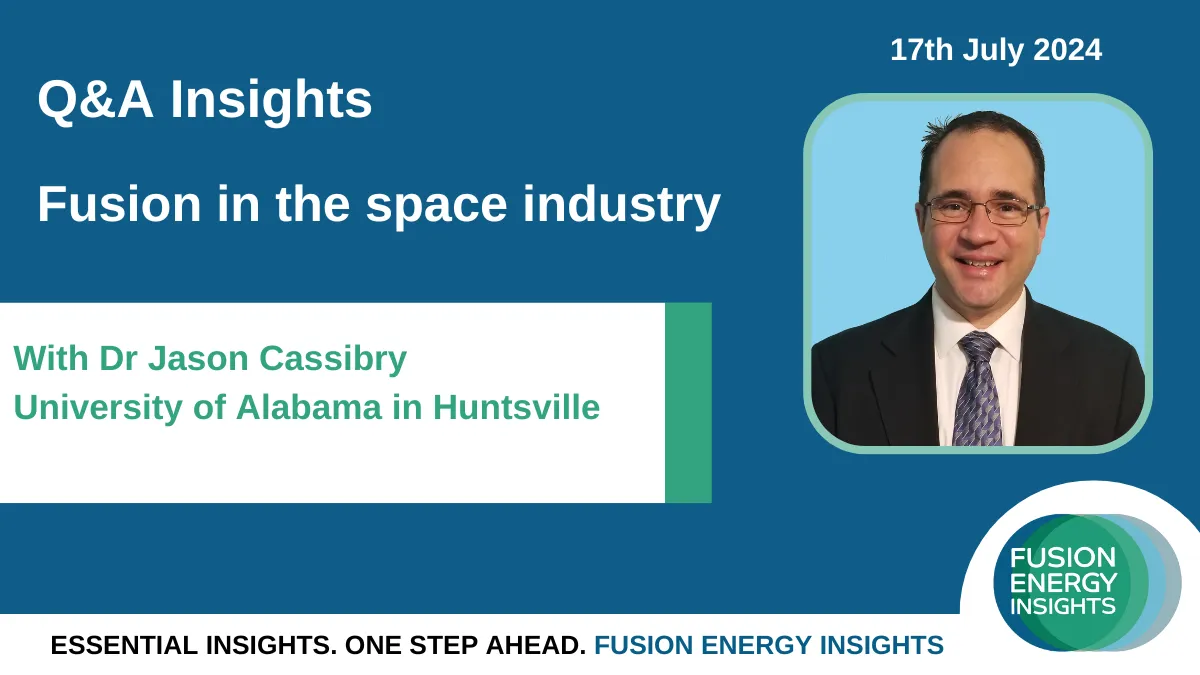3 Key Insights – Fusion in the Space Industry
In our member Q&A session on the 17th July 2024, we discussed fusion in the space industry. Fusion has a wider range of applications than energy generation and one such use is fusion propulsion to enable travel in space.
Why should we care about fusion propulsion?
What can fusion propulsion do that others in the space travel sector cannot?
Our expert for this session was Jason Cassibry, a professor in the Department of Mechanical and Aerospace Engineering and affiliated with the Propulsion Research Center at the University of Alabama in Huntsville. Jason explained how fusion could enable faster and further space travel, which could bring many benefits, but said that a working fusion-propelled vehicle still needs to be prototyped.



Here are three key insights from the event.
1. Fusion propulsion for space travel is becoming increasingly viable
Jason argues that fusion propulsion is becoming increasingly viable due to the combination of three factors that have occurred over the past decade:
- More research on plasma physics in general, which has important implications for fusion propulsion
- Private money flowing into fusion propulsion
- Credible designs for fusion-powered rockets
Jason believes that fusion will help humans get to Mars in the near future. Jason says, “right now, NASA is planning on a nuclear thermal propulsion system to take humans to Mars and that'll probably happen in the 2030s. But with all of these private launch companies wanting to get out there and explore and contribute, I think fusion is going to get introduced, and as we achieve break-even it becomes a reality.”
He continued: “The astronauts that want to go to Mars are not going to want to spend six months out in deep space exposed to the elements. And so if suddenly, you have a technology that can get there in two or three months, that's disruptive. I absolutely think that fusion is going to follow behind nuclear thermal and then become the dominant propulsion system.”
It is predicted that a return trip to Mars with fusion propulsion could take six months. However, more sustained funding is needed for fusion propulsion research to allow the jump from research to demonstration devices. There are many designs for space vehicles fuelled by fusion. There are no functioning prototypes of these vehicles yet.
2. First-generation systems in fusion energy and fusion propulsion will have significant overlap
Jason explains: “What I anticipate is that the first generation systems that are used are going to have a tremendous amount of overlap between terrestrial power and propulsion, simply because our portfolio of what works is going to be pretty small and narrow at the time. So it will be primitive by the standards that follow years or decades after that. “But then I think as people start to use these technologies more, those systems that work best for these different applications will probably evolve into some sort of convergent design that that is optimum for that particular application.
“It's like, an internal combustion engine for a car looks very different from the combustion system on a rocket even though they're both based on fire and burning things chemically. So I think that the the appearance and technologies and things will diverge considerably over time as they're used.”
Fusion research on power generation and propulsion could be seen as complimentary. Both areas can learn from the other.
High temperature superconducting magnets are critical in fusion systems for power generation, but developments are also very important for fusion propulsion; for example the magnets allow plasma confinement which allows the capture of the high density reaction which can be used for propulsion, so enabling high speeds of travel for fusion-powered rockets.
Jason says: fusion propulsion “doesn't attract as much private funding as fusion for terrestrial power does, but it does get significant amounts of funding. The two companies that have generated the most in fusion propulsion are Helicity Space and Pulsar Fusion … whereas for terrestrial power, a couple of companies have at least raised around a billion dollars or hundreds of millions and so I think just from that evidence it suggests that people are looking at terrestrial power as the bigger benefit in the short term.”
Jason says it is very difficult to have a career in only fusion propulsion. He argues that it is best to undertake fusion research in general and find the common areas where fusion research is needed, but can be applied to space travel.

Artist rendering of fusion concept engine. Image: Helicity
3. The commercial niche for fusion propulsion will be service missions in Lower Earth Orbit and beyond
Jason argues that the commercial proposition for fusion propulsion is two-fold. Firstly, fusion propulsion has great value for service missions, for example bringing new supplies to the International Space Station or undertaking repairs or removing space debris. Secondly, for fusion propulsion “the natural next frontier is lunar space” says Jason, which means expanding space travel from the Lower Earth Orbit (LEO) – within 2000km of Earth – to the cis-lunar space, which is the area between the Earth and the surface of the moon.
“Right now,” says Jason, “it appears that there is a movement towards expanding into cislunar space—that low Earth orbit and geostationary are kind of getting crowded. And the natural next frontier is lunar space. And so I think, commercially, you're probably going to have defense contractors first, but I think ultimately, as additive manufacturing improves and you can go out in space and live and dwell in space and make things from stuff in space. I think that that's going to have a big payback in the long term.”
Regarding fusion specifically, Jason says, “I would anticipate that return on investment for investors would come in the form of defense and service industries first, to help support the satellite infrastructure that builds out into cislunar space.”
And finally…
The inherent and perpetual innovative spirit of the fusion research community was referred to in Jason’s talk.
“Fusion has a way of making me eat crow* over and over again in my career, because we all have our favourite concepts that we pursue. And for me, it's magneto inertial fusion. And for the longest time, I dismissed magnetic confinement and inertial because the main reactors were so huge, they just looked like they would not be economical. But over time, people solve those problems and shrink it down. And so it's really a testament that the fusion community as a whole is just full of people with a can do attitude and spirit about solving those big problems and making it affordable, and helping to improve humanity in a variety of ways through terrestrial power, propulsion and medical isotopes.”
[Ed. – a colloquial phrase meaning to become aware of one’s own mistakes]
Fusion energy is coming. The fusion industry is growing. Can you afford not to be informed?
Subscribe to our free fusion newsletter.
Get all the insights and access to the FEI community by becoming a member of Fusion Energy Insights today.
